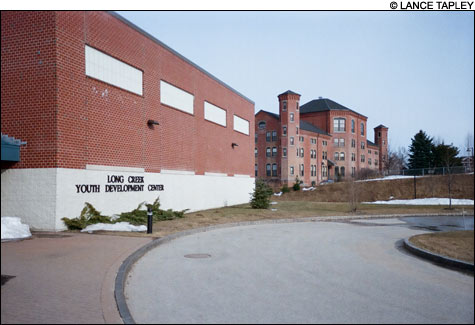
DAYS OF FUTURE PASSED The entrance to the modern Long Creek Youth Development Center, with the old Maine Youth Center administration building in the background. |
Fixing Maine’s troubled prisons is not an impossible task. In fact, if the state treated adult inmates more along the lines of how it treats juvenile offenders, prison critics — including, surprisingly, the new corrections commissioner, Joseph Ponte — think the prisons might not only become more humane, they might actually “correct” the prisoners.
In his February confirmation hearing before the Legislature’s Criminal Justice Committee, Ponte admitted he didn’t have much experience in juvenile corrections. But that was okay, he said, because youth detention in Maine worked well. He was repeating something widely accepted. Former commissioner Martin Magnusson bragged about the low recidivism rate — the return to crime — of the adolescents in his department’s custody.
Maine’s adult prisons are another story — especially, the Maine State Prison in Warren, with its mysterious inmate deaths, its suicides and suicide attempts, its solitary-confinement “supermax” filled with the mentally ill, and its “organizational culture,” as a 2009 legislative investigation put it, featuring intimidation, retaliation, and harassment suffered by both inmates and staff. And although the Department of Corrections doesn’t have rock-solid numbers for adult recidivism in Maine, nationally more than two-thirds of released prisoners are re-arrested within three years.
Behind the differences in outcome lies a vast difference in philosophy. The Maine juvenile system is oriented toward treatment, the adult prisons — while giving lip service to corrections — toward punishment.
“If less repressive — if positive — techniques can work with kids, why not with adults?” asks Judy Garvey, a Maine Prisoner Advocacy Coalition leader.
Ponte, who Governor Paul LePage’s office says was brought to Maine to fix “issues” in corrections, is asking the same question.
Among his first decisions was to fire the two associate commissioners associated with the adult prisons — Harold “Bud” Doughty and Denise Lord — and retain the third associate commissioner, Bartlett “Barry” Stoodley, the head of juvenile corrections.
“He’s outcome oriented,” Stoodley says of his boss.
“The punishment is what the court gives, the sentence,” Ponte says. “We’re not in the business of punishment, but corrections. We’ve got a lot to learn from the juvenile system.” But, he adds: “It’s going to take a philosophical change” in the department.
Is it really successful?
Why does Maine’s juvenile corrections work well? But, first, how do we know it does?
Rodney Bouffard, superintendent of the Long Creek Youth Development Center in South Portland, can pull from his desk a sheaf of national accreditation reports and awards attesting to the good reputation of his 110-“resident” facility. It’s one of two Maine juvenile detention centers, the other the similarly sized and, according to Bouffard, similarly successful Mountain View Youth Development Center in Charleston in Penobscot County.
In 2009 Long Creek won a national award for its reduction in two years from 419 to 15 instances of what the center calls “observation” and amounts to solitary confinement. Its restraint chair has been mothballed and Bouffard says only 12 restraints were necessary last year on out-of-control kids, as opposed to 480 in 1999. In most cases, he says, restraint now means staff members hold the individual against a wall for a few minutes while “We talk ’em down.”